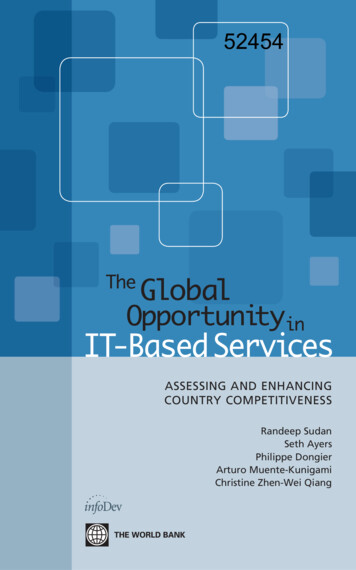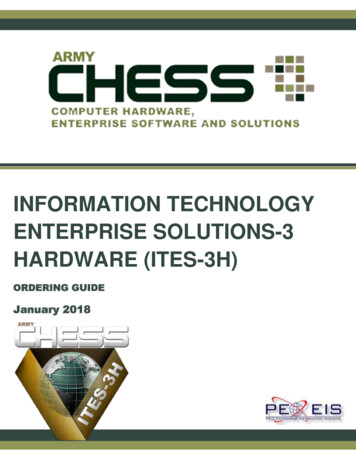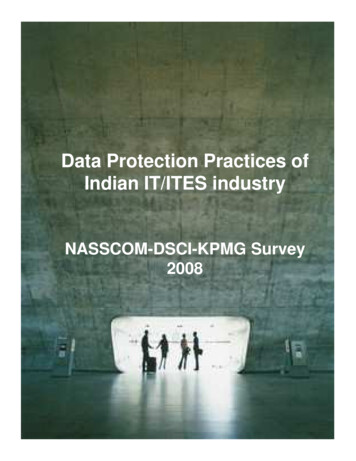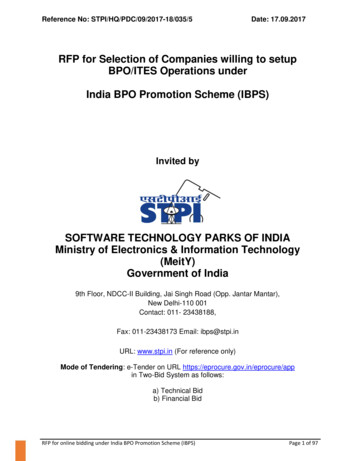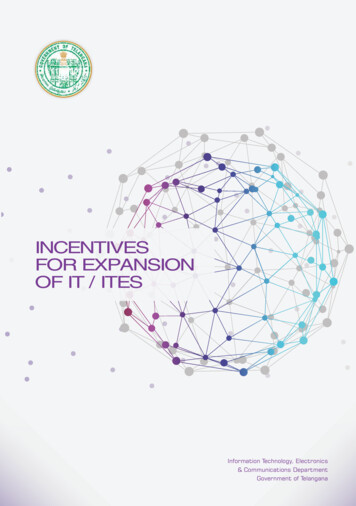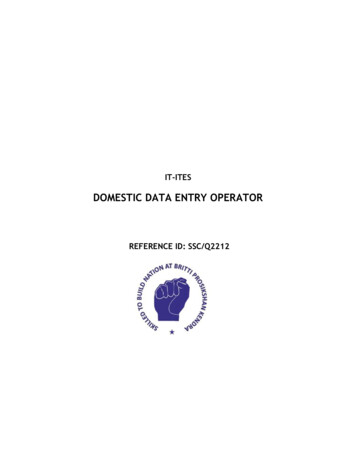
Transcription
IT-ITESDOMESTIC DATA ENTRY OPERATORREFERENCE ID: SSC/Q22120 Page
WELCOME NOTEInformation Technology (IT) and Information Technology-enabled Services (ITeS) are one of the mostsignificant growth stimulator of the Indian economy. IT industry has not only influenced the employmentprospects of the people but also affected the social lives of the people by connecting them throughnetwork and social websites. The major segments of the Industry are IT Services, Business ProcessOutsourcing (BPO), engineering services, research and development and products. IT Products beingmanufactured in India include personal computers, servers, workstations, supercomputers, dataprocessing equipment, printers, digitizers, etc. Much of the IT related activities are centred on servicesin Banking, Financial Services, Insurance, Telecommunication, Manufacturing, and Retail.Indian IT Industry has been contributing substantially to India's Gross Domestic Product, exports andemployment. The sector is responsible for enabling employment to an additional 8.9 million people invarious associated sectors, such as security, transportation, housekeeping, catering, etc. It has growntremendously over the last 15 years. The industry employs around 2.2 million people.IT Helpdesk Attendant in IT-ITeS Industry is also known as Helpdesk Executive, Service Desk Executive,Technology Support Executive, IT Support Executive, and Helpdesk Coordinator. An IT helpdesk attendantis the initial point of contact for internal company customers seeking assistance and support with thecompany’s intranet, desktop devices, and other business applications that are maintained by the supportteam. Primary responsibility of individuals at this job is to provide user support, managing CustomerService Desk application, responding to all incoming service requests and customer service; quicklydiagnose technical issues and arrange solutions during normal operational business hours. He/she shouldbe responsible for the smooth running of computer systems and ensuring users get maximum benefitsfrom them.The tasks of a Helpdesk Attendant vary depending on the size and structure of the organization and mayinclude installing and configuring computer hardware operating systems and applications; monitoring andmaintaining computer systems and networks; dealing with staff/clients either face to face or over thetelephone to help set up systems or resolve issues; troubleshooting network problems and diagnosing andsolving hardware/software faults of IT Helpdesk Attendant.The job of IT Helpdesk Attendant requires the individual to have thorough knowledge of varioustechnology trends and processes as well as have updated knowledge about IT initiatives. He/she shouldbe highly motivated and energetic to timely respond to all issues, updates internal customers on status,solicits additional information, and troubleshoots issues. IT Helpdesk Attendant can explore jobopportunities in IT multi-national companies, private IT organizations, IT call centers, IT software orequipment suppliers, IT maintenance companies, etc.This Student Handbook will help you learn and practice the skills required to become a Domestic ITHelpdesk Attendant. You can highlight the important points and make notes too. The more you interactwith the handbook, the more you learn.It contains Activities to be performed in class and at home as well as Study Material for you to read.This handbook will help you to learn better during the course and be useful later as a reference.1 Page
You will find this course material useful both for studying and as future reference. We welcome yourfeedback on any issue relating to this course and wish you all the best. Happy Learning!Objectives of the CourseUpon completion of this course, you will be able to: Demonstrate the knowledge of modern computers and their parts and peripherals Communicate effectively at workplace Describe the use of various operating systems and software Demonstrate the knowledge of health, safety and security issues and follow best practices Demonstrate the knowledge of helpdesk system fundamentals Demonstrate the knowledge of fundamentals of network operating systems2 Page
Table of ContentsUnit - 1Introduction to IT-ITES IndustryPage No.(5-26) Unit - 2Introduction to IT-ITES IndustryObjectives of the CourseMeaning of Domestic Date Entry OperatorRoles & Responsibilities of Domestic Date Entry OperatorRequired Skills to become an Domestic Date Entry OperatorComputer FundamentalsPage No.(27-35) Unit - 3Undertake Data Entry Services Unit - 4Basic SoftwareOperating System and SoftwareApplication SoftwareMicrosoft Office Excel 2007InternetGmailData Analysis PackageHelpdesk systems, policies, and proceduresAdvantages/Importance of Help DeskPlanning and Organising Work to Meet Expected Outcomes Unit - 5History of ComputersAdvantages & Disadvantages of ComputersHardware & SoftwareClassification of SoftwareSystem Software & Application SoftwareUtility ProgramsLibrary ProgramsMaintaining Cleanliness at WorkSelf-Discipline and PunctualityComplying with Company Policy and RulesChecking Work for AccuracySeeking Advice and Guidance from Line ManagerUnderstanding the Work Output RequirementsMaintain a Healthy, Safe and Secure Working Environment Complying with organization’s current health, safety andsecurity policies and proceduresReporting any identified breaches in health, safety, andsecurity policies and proceduresPage No.(36-83)Page No.(84-102)Page No.(103-110)3 Page
Identifying and correcting any hazards that you can deal withsafelyReporting any hazards that you are not allowed to deal withto the relevant personIdentify and recommend opportunities for improving health,safety, and security to the designated personFollowing Emergency ProceduresComplete any health and safety records legibly andaccurately4 Page
Unit 1 – Introduction to IT-ITES IndustryLearning Objectives: Introduction to IT-ITES IndustryObjectives of the CourseMeaning of Domestic Data Entry OperatorRoles & Responsibilities of Domestic Data Entry OperatorRequired Skills to become a Domestic Data Entry OperatorIntroduction to IT-ITES ServicesInformation Technology (IT) and Information Technology-enabled Services (ITeS) are one of the mostsignificant growth stimulator of the Indian economy. IT industry has not only influenced the employmentprospects of the people but also affected the social lives of the people by connecting them throughnetwork and social websites.The major segments of the Industry are IT Services, Business Process Outsourcing (BPO), engineeringservices, research and development and products. IT Products being manufactured in India includepersonal computers, servers, workstations, supercomputers, data processing equipment, printers,digitizers, etc. Much of the IT related activities are centered on services in Banking, Financial Services,Insurance, Telecommunication, Manufacturing, and Retail.Indian IT Industry has been contributing substantially to India's Gross Domestic Product, exports andemployment. The sector is responsible for enabling employment to an additional 8.9 million people invarious associated sectors, such as security, transportation, housekeeping, catering, etc. It has growntremendously over the last 15 years. The industry employs around 2.2 million people.Internet has made revolutionary changes with possibilities of online booking of tickets rail or air, filingIncome Tax returns, online application for passports, online banking, etc. With an internet user-base ofover 125 million, which is likely to grow to about half-a-billion over the next few years, and also anestablished base of 950 million mobile users, India will be a key player in the cyber-world.With biometric technology fast maturing and becoming increasingly sophisticated, biometric solutionsare starting to make serious inroads as a high-tech identity management and verification tool within thesociety. Such momentum has introduced the new possible markets for biometric data operator which hasthe largest impact on future societies. Future scope of the biometric systems in customer‟s identificationand authentication is seen in access and attendance control, travel control, financial and othertransactions requiring authorization, remote voting (authorization) and use in automatic working devices.Objectives of the CourseUpon completion of this course, you will be able to: Demonstrate the knowledge of modern computers and their parts and peripheralsDemonstrate the knowledge of using keyboard with specific speed limitCommunicate effectively at workplaceDescribe the use of various operating systems and softwareDemonstrate the knowledge of health, safety and security issues and follow best practices5 Page
Demonstrate various data entry servicesData Entry OperatorDomestic Data Entry Operator in IT-ITeS Industry is also known as Data Entry Operator.A Data Entry Operator is an individual responsible to provide daily work reports.Roles & Responsibilities of Domestic Data Entry OperatorA data entry operator types information into a computer program using a keyboard and/or acomputerized 10-key pad. These workers may enter names, addresses, statistical information, businessinformation, account numbers, or other data. They are hired by companies and organizations that needto have large quantities of data processed quickly, and on a regular basis.The most important skills in a data entry operator's arsenal are speed and accuracy. Employers want tohire the operator that can enter the most amount of information in the least amount of time. Quick entrymeans fewer labour hours per project, which saves the company money over time.While speed is important, an employer must also be confident that the operator is entering theinformation accurately. Incorrect information is usually useless and can be dangerous. For example, anoperator at a hospital might enter that John Smith is allergic to a common antibiotic. If, in fact, it isJohn Smithe that has the allergy, a clinician who looks up John Smithe's chart will not find the warningand may inject the patient with a drug that could kill him.Other job competencies that are important to data entry operators are basic computer skills and 10-keyskills. Operators most often enter information into basic database forms, so advanced computer skillsare rarely required. The ability to start a program, open a window, use a mouse, and submit a form arevital, however. Use of a 10-key pad is critical to those entering a lot of numbers because 10-key entry ismuch faster than entry using the number keys on a standard keyboard. Since operators are often exposedto highly-sensitive information — such as Social Security numbers, account numbers, and sales data —discretion and honesty are also valuable traits.A data entry operator can work in a wide array of fields and settings. Hospitals employ them to enterpatient information, vendor data, and compliance reports. Direct marketing firms hire them to enterprospective customer information. Many businesses hire such workers in their accounts payable, accountsreceivable, sales, marketing, logistics, or operations departments.The Necessary SkillsIf you’re an IT worker, these skills are the basics that IT help desks look for:1. Troubleshooting PC problems in real lifeCan you diagnose malware incidents quickly? Are you the person your neighbours/roommates/familycall when they can’t get the printer to work?2. You know when it’s time to do an OS reloadKnowing when to cut your losses is both an art and a science.6 Page
3. You have good research capabilities on Google and other search enginesWhen your grasp of terminology helps you do great research for figuring out unusual problems, yourvalue to an IT help desk increases.4. You have your A , Microsoft-certified desktop support technician, and Network certificationsHelp desk workers generally have an associate’s or bachelor’s degree, certifications, or diplomas ininformation technology and a handful of basic certifications.5. You understand the importance of good customer service skills.After all, it isn’t just about technology. It’s about helping people do their jobs.Great Bonus Qualifications1. Excellent writing skills.If you write clearly and grammatically and can express technical problems and solutions that the averageend user can understand, then you will be a big asset to an IT help desk, particularly if it uses help desksoftware that builds a knowledge base from resolved tickets.2. Great phone skills.Your phone interview is extremely important, not just for discussing qualifications, but also because yourpotential employer can gauge your phone skills. If you make it clear that you’re listening, don’t interrupt,and answer in a friendly and thoughtful manner, you’re gold.3. Good mechanical skills.If you have skills making mechanical and electrical things work, this can be a big plus to an IT help desk.Skills That Say, “Hire This Person Immediately.”There are few more skills that should prompt a smart IT recruiter to hire you:1. Direct experience with (or certifications from) software and hardware vendorsIf these match up with the vendors the employer uses, you have a huge advantage over applicants withoutthis experience.2. Freelance developer experienceIf you have freelance developer experience, not only do you have the technical skills necessary forIT help desk work, you also have the initiative and discipline to get things done without beingmicromanaged.3. Programming language certifications.If you have experience or certifications, you probably have the strong attention to details plus theanalytical skills that any company would like to have in a help desk worker.7 Page
Great IT help desk workers and great help desk software are two of the best investments a company canmake. A consistently updated knowledge base with resolved service tickets and a self-service portal thatallows motivated end users to solve their own minor IT problems, help desk workers are free to tacklethe more difficult IT issues that arise, allowing your business to run smoothly and prevent wasted time.The organization you work for would normally have its standards, policies, procedures and bestpractices spelt out as its data policy which is appropriately documented and made available toemployees and other stake holders as guidelines for data handling and management. Eachorganization would usually have its own policies depending on the kind of work it is involved in.However, there are some generic policies, procedures and best practices as listed below whichshould give a fairly clear idea in the context.Key ParameterData OwnershipData CollectionData ValidationData FormattingData StorageData ProtectionData RetentionData AnalysisHow it relates to Data Entry FunctionsThis pertains to who has the ownership andrights to the data and who retains the dataduring and after the corresponding work iscompleted.This pertains to collecting data in a consistent,systematic manner (i.e., reliability) andestablishing an ongoing system for evaluatingand recording changes to the work protocol(i.e., validity).This pertains to validation and correction ofcollected data as per established anddocumented guidelines prior to use of the datain the concerned work or project.This pertains to the formats (font, size, colour,indentation, structuring, etc.) to be followed fordata entry.This concerns where and in what format shouldthe data be stored. It also pertains to amount ofdata that should be stored --enough so that workresults can be reconstructed. Data backupprocedure, frequency, etc. are also a part of thispolicy.This relates to protecting written and electronicdata from physical damage and protecting dataintegrity, including damage from tampering ortheft.This refers to the length of time one needs tokeep the data according to the sponsor's orfunder's guidelines. It also includes securedestruction of data.This pertains to how raw data are chosen,evaluated, and interpreted into meaningful and8 Page
How to engage with both internal and external specialists for support in order to perform the desiredtaskThe job data entry involves multiple functions yielding collective team delivery. Understandably, severalinternal and external experts and specialists are engaged during the delivery process. Following are sometools used to engage the specialists.Intranet Tools:An intranet is a computer network that uses Internet Protocol technology to share information,operational systems, or computing services within an organization. This term is used in contrast tointernet, a network between organizations, and instead refers to a network within an organization.Sometimes, the term refers only to the organization's internal website, but may be a more extensive partof the organization's information technology infrastructure, and may be composed of multiple local areanetworks.The objective is to organize each individual's desktop with minimal cost, time and effort to be moreproductive, cost efficient, timely, and competitive.Significance of Intranet:Workforce productivity: Intranets can help users to locate and view information faster and useapplications relevant to their roles and responsibilities. With the help of a web browser interface,users can access data held in any database the organization wants to make available, anytime and— subject to security provisions — from anywhere within the company workstations, increasingemployees' ability to perform their jobs faster, more accurately, and with confidence that they havethe right information. It also helps to improve the services provided to the users.Time: Intranets allow organizations to distribute information to employees on an as-needed basis;Employees may link to relevant information at their convenience, rather than being distractedindiscriminately by email.Communication: Intranets can serve as powerful tools for communication within an organization,vertically strategic initiatives that have a global reach throughout the organization. The type ofinformation that can easily be conveyed is the purpose of the initiative and what the initiative isaiming to achieve, who is driving the initiative, results achieved to date, and who to speak to formore information. By providing this information on the intranet, staffs have the opportunity to keepup-to-date with the strategic focus of the organization. Some examples of communication would bechat, email, and or blogs. A great real world example of where an intranet helped a companycommunicate is when Nestle had a number of food processing plants in Scandinavia. Their centralsupport system had to deal with a number of queries every day. When Nestle decided to invest in anintranet, they quickly realized the savings. McGovern says the savings from the reduction in querycalls was substantially greater than the investment in the intranet.Web publishing allows cumbersome corporate knowledge to be maintained and easily accessedthroughout the company using hypermedia and Web technologies. Examples include: employeemanuals, benefits documents, company policies, business standards, news feeds, and even training,can be accessed using common Internet standards (Acrobat files, Flash files,). Because each businessunit can update the online copy of a document, the most recent version is usually available toemployees using the intranet.9 Page
Business operations and management: Intranets are also being used as a platform for developingand deploying applications to support business operations and decisions across the internetworkedenterprise.Cost-effective: Users can view information and data via web-browser rather than maintainingphysical documents such as procedure manuals, internal phone list and requisition forms. This canpotentially save the business money on printing, duplicating documents, and the environment as wellas document maintenance overhead. For example, the HRM company PeopleSoft "derived significantcost savings by shifting HR processes to the intranet".Enhance collaboration: Information is easily accessible by all authorized users, which enablesteamwork.Cross-platform capability: Standards-compliant web browsers are available for Windows, Mac, andUNIX.Built for one audience: Many companies dictate computer specifications which, in turn, may allowIntranet developers to write applications that only have to work on one browser (no cross-browsercompatibility issues). Being able to specifically address your "viewer" is a great advantage. SinceIntranets are user-specific (requiring database/network authentication prior to access), you knowexactly who you are interfacing with and can personalize.Promote common corporate culture: Every user has the ability to view the same information withinthe Intranet.Immediate updates: When dealing with the public in any capacity, laws, specifications, andparameters can change. Intranets make it possible to provide your audience with "live" changes sothey are kept up-to-date, which can limit a company's liability.Supports a distributed computing architecture: The intranet can also be linked to a company’smanagement information system, for example a time keeping system.Intranet tools:These are the 5 intranet software tools that have proven to be cost-effective and productive web-basedtools for organizations of all sizes.Igloo Software - Igloo specializes in social intranets for document management, including version controland commenting on all content types (micro blogs, wikis, discussion forums, tasks and documents).Community channels for ongoing employee interactions called Spaces can be administered by specificfunctional group, like HR, sales, or engineering. Igloo Software is a 100 percent cloud-based platform,and also deploys extranets, external facing communities or a mixed hybrid of public and private areas.Interact-Intranet - Users particularly like the unity of forums for discussions, ideas, and questions, whereeveryone can post answers, likes and votes. Offering cloud services or on premises software, InteractIntranet takes pride in the fact that it has been built in-house from the ground up and runs on theMicrosoft technology stack.Moxie Software - Moxie Software’s Collaboration Spaces are designed with the user in mind, especiallyits well developed employee profile pages. The central intranet platform, a hub and spoke-like network,10 P a g e
keeps employees connected. A broad range of web 2.0 tools are included, like the newsfeed, blogs, ideastorms (for managing innovation challenges), discussion forum, task lists, wikis, and others.Podio - Podio, owned by Citrix Systems, Inc. is a contemporary model for intranets, providing ready-builtand build-your-own apps to fill the employee's workspace. The Employee Network is the common areawhere interactions in real time in the activity stream provide visibility for employees online. Groups canget creative using the Intranet App Pack, presented as a collection of apps to share documents, hostmeetings, and track corporate communications.XWiki - XWiki is owned by XWiki SAS, a French company. XWiki offers a cloud services model ordownloadable open source software to run on your company server, where you can also design your ownapps. XWiki helps groups organize workspaces, organize and manage documents, and utilize web 2.0tools, including blogging, discussion forums, wikis, and a variety of applications for tasks, budgets, andreports, among other uses.Data entry procedures, tools, and techniquesThe process of data entry involves not only typing information into the computer, but also implementinga whole set of procedures for preparing and organizing the questionnaires and processing and verifyingthe data. Although most people focus on the computer aspect of data entry, many of the problemsinvolved in successfully organizing a data entry system are related to management rather than to thecomputer.In this system, data entry is carried out concurrently with data collection. A flow chart of the completesystem begins when the questionnaires are first received in the office and continues through severallevels of data verification (see Figure KA3.1). This chapter covers the steps from questionnaire receptionthrough data entry followed by data verifications and cleaning.Figure KA3.1 - Flow chart of data entry and verification system11 P a g e
It is beneficial to include a list of instructions covering all data entry and verification procedures in aprocedures manual. This manual should be in the form of a loose-leaf notebook, so that it can beaugmented and modified as procedures are revised. It might include specific instructions for correctingcertain types of errors or key-stroke-by-key-stroke descriptions of how to use the data entry and analysissoftware. The manual would serve as a reference to all staff and help ensure that everyone is followingthe same procedures.Figure KA3.2 - Batch and questionnaire numberingSTEP 1 – Reception of QuestionnaireIt is important to have established procedures for collecting questionnaires from the field and forhandling them once they have been received. During a long survey, the questionnaires should becollected periodically from the enumerators so that they may be entered into computer files. Uponreceiving the questionnaires, they should be separated into batches by type. That is, all thequetioneries should be put in one batch, all the crop transaction questionnaires in another, and so forth.If the batches are quite large, they may be further separated by region or village.Once the questionnaires have been separated into batches, they are sorted by their key variables andnumbered sequentially. In the case of the household census, the questionnaires would be sorted byvillage, household, and the ID number of the household member. The questionnaire numbering is veryimportant because it keeps the questionnaires in order and allows one to see quickly if a questionnaireis missing. The questionnaire numbers can also be entered into the data file, making it easier to find thequestionnaire corresponding to a particular record. For multiple page questionnaires, each sheet withina particular questionnaire should have the same number.Figure KA3.3 - Data entry and verification batch control form12 P a g e
13 P a g e
Figure KA3.2 - ContinuedThe questionnaire numbering should continue from one batch to the next for the same type ofquestionnaire. For example, if the last page number in the first batch of household census questionnaireswas 54, the numbering of the next batch of census questionnaires should start with 55. In this way, notwo questionnaires of a given type will have the same number. The batches themselves are alsonumbered, so that the first batch of census questionnaires will be number 01, the second 02, and so forth(see Figure KA3.2).Once the questionnaires have been sorted and numbered, a Data Entry and Verification Control Form(Figure KA3.3) is attached to each batch. This form is used to record the completion of the differentsteps in the data entry and verification process. The following information is entered in the form header:the date when the batch was received, the questionnaire ID number (which identifies the questionnairetype), and the batch number. The summary box below the header has a check list of all the major stepsand allows one to see immediately the status of the questionnaire.The receipt of the questionnaires is recorded in a logbook as shown in Figure KA3.4. The logbook isdivided into separate sections for each questionnaire type. Each time questionnaires are delivered to the14 P a g e
office, the batch number and the date the batch was received are entered in the logbook. In addition,each village included in the batch is listed along with the number of questionnaires and the dates of thefirst and last interviews. This allows one to keep track of which questionnaires have been brought in fordata entry and which are still in the field. The number of questionnaires is totaled at the end of eachentry.Figure KA3.4 - Logbook entry for recording the receipt of questionnairesSTEP 2 – Questionnaire PreparationBefore the questionnaires can be entered, they must be prepared, which involves a visual inspection ofeach questionnaire for missing or inconsistent information. (Of course, the questionnaires should also beinspected in the field by the enumerator or the field supervisor before they are brought to the office.)Questionnaire preparation is an extremely important step that is often omitted for the sake ofexpediency. Experience has shown, however, that this step can reveal many data collection problemsand that more time is wasted by allowing such problems to go undetected until the later stages. In thequest to find data errors, the motto must be "the sooner, the better.The person preparing the questionnaires must be quite familiar with them so that he or she will be ableto interpret correctly the information on them. The preparer writes in codes for any uncoded responsesand searches for missing responses, inconsistent information, or entries that simply "don't look right."This requires someone with a careful eye and a good "feel" for the data.15 P a g e
IT Helpdesk Attendant in IT-ITeS Industry is also known as Helpdesk Executive, Service Desk Executive, Technology Support Executive, IT Support Executive, and Helpdesk Coordinator. An IT helpdesk attendant is the initial point of contact for internal company customers seeking assistance and support with the
